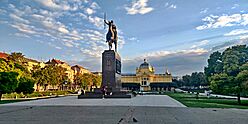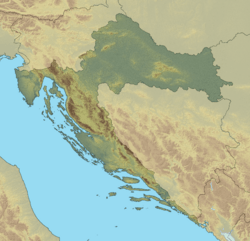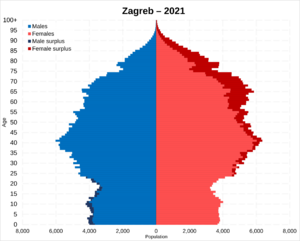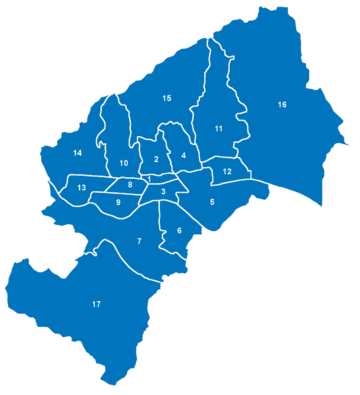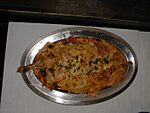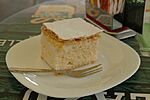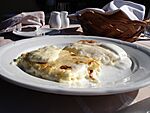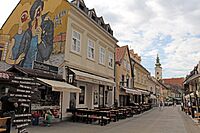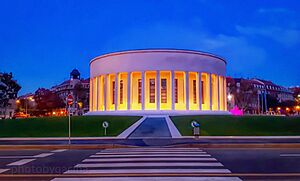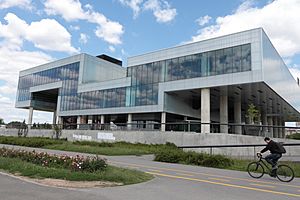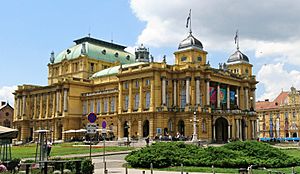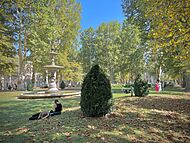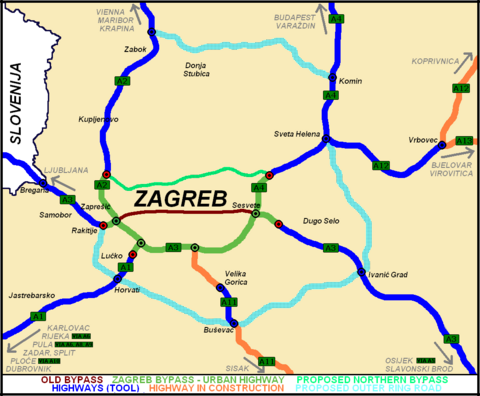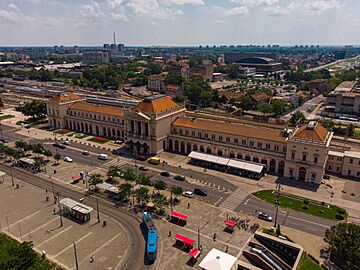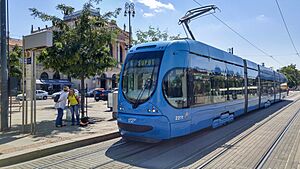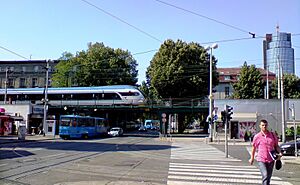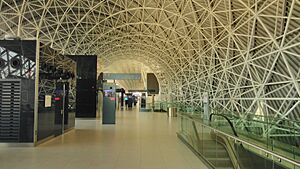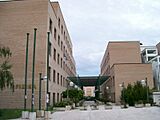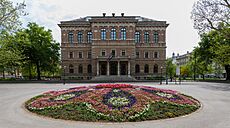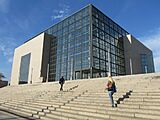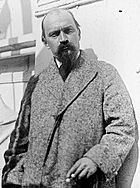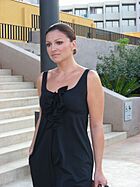Zagreb facts for kids
Quick facts for kids
Zagreb
|
|||
|---|---|---|---|
|
Capital city and county
|
|||
| Grad Zagreb City of Zagreb |
|||
|
Ban Jelačić Square with Zagreb Cathedral
Croatian National Theatre
St. Mark's Square
Stone Gate in the Upper Town
Cibona and HOTO towers
Lexicography Institute
Mimara Museum
Art Pavilion and Monument of the King Tomislav of Croatia
|
|||
|
|||
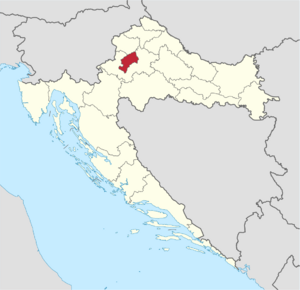
The city of Zagreb in Croatia
|
|||
| Country | |||
| County | City of Zagreb | ||
| RC diocese | 1094 | ||
| Free royal city | 1242 | ||
| Unified | 1850 | ||
| Subdivisions | 17 city districts 218 local committees 70 settlements |
||
| Government | |||
| • Type | Mayor-Council | ||
| Area | |||
| • City | 641.2 km2 (247.6 sq mi) | ||
| • Urban | 162.2 km2 (62.6 sq mi) | ||
| Elevation | 158 m (518 ft) | ||
| Highest elevation | 1,035 m (3,396 ft) | ||
| Lowest elevation | 122 m (400 ft) | ||
| Population
(2021)
|
|||
| • City | 767,131 | ||
| • Density | 1,196.40/km2 (3,098.66/sq mi) | ||
| • Metro | 1,217,150 | ||
| Demonym(s) | Zagreber (en) Zagrepčanin (hr, male) Zagrepčanka (hr, female) Purger (informal, jargon) |
||
| GDP | |||
| • City | €20.284 billion | ||
| • Per capita | €25,100 | ||
| Time zone | UTC+1 (CET) | ||
| • Summer (DST) | UTC+2 (CEST) | ||
| Postal code |
HR-10 000, HR-10 010, HR-10 020, HR-10 040, HR-10 090
|
||
| Area code | +385 1 | ||
| Vehicle registration | ZG | ||
| HDI (2022) | 0.938 – very high | ||
Zagreb is the capital and largest city of Croatia. It is located in the northern part of the country, along the Sava river. The city sits at the base of the Medvednica mountain, close to the border with Slovenia. Zagreb is about 158 meters (518 feet) above sea level. In 2021, the city itself had a population of 767,131 people. The wider Zagreb area, including nearby towns, has about 1.2 million residents.
Zagreb has a long and interesting history, going back to Roman times. The first mention of the name "Zagreb" was in 1134. At that time, it was two separate towns: Kaptol and Gradec. In 1851, these two towns officially joined together. Today, Zagreb is a very important city for Croatia. It is a major center for business, science, and transportation. It is also known for its many museums, sports events, and fun activities.
Contents
About the Name of Zagreb
The exact meaning of the name Zagreb is not fully clear. It was first used for the united city in 1852. However, the name was used for the Zagreb Diocese much earlier, in the 12th century.
One popular story about the name comes from a folk legend. It says that a thirsty city governor once told a girl named Manda to "scoop" water from a well. In Croatian, "scoop" is Zagrabi!, and the girl's name was Manda. So, the well became known as Manduševac, and the city's name is said to come from this phrase: Zagrabi, Mando! ("Scoop, Manda!").
History of Zagreb
The oldest known settlement near Zagreb was the Roman town of Andautonia. Its ruins can still be seen today near the village of Ščitarjevo.
The name "Zagreb" first appeared in 1094. Back then, the city was actually two separate towns:
- Kaptol: This was the eastern part, mainly home to clergy (church officials) and the Zagreb Cathedral.
- Gradec: This was the western part, where craftsmen and merchants lived.
In 1242, both towns were attacked by the Tatars. After this, King Béla IV of Hungary gave Gradec special rights, making it a "free royal city." This meant its citizens had more freedom and their own judicial system.
For a long time, Kaptol and Gradec had many disagreements, especially about land and money. Sometimes, these fights even led to violence. But in 1851, the two towns finally united into one city. Josip Jelačić, a famous Croatian leader, helped make this happen. The main square in Zagreb, Ban Jelačić Square, is named after him.
Zagreb as a Capital City
Zagreb became the capital of Croatia in 1557. It was also chosen as the home of the Ban of Croatia, a high-ranking official, in 1621.
In 1669, a group called the Jesuits came to Zagreb. They built the first grammar school and founded an academy. This academy later became the University of Zagreb, which is still very important today.
During the 17th and 18th centuries, Zagreb faced many challenges, including fires and the plague. In 1776, the government moved its main offices to Zagreb, making it even more important.
Zagreb in the 19th and 20th Centuries
In the 19th century, Zagreb became the center of the Croatian National Revival. This was a time when Croatians worked to strengthen their national identity and culture. Many important cultural and historical places were founded during this period.
In 1850, the two towns of Gradec and Kaptol officially joined together. Janko Kamauf became Zagreb's first mayor.
The city grew rapidly. In 1862, the first railway line connected Zagreb to other cities. A gasworks opened in 1863, and a waterworks in 1878. After a big earthquake in 1880, the city was rebuilt and got its modern look. The first horse-drawn tram started running in 1891.
Since 1877, the Grič cannon has fired every day from the Lotrščak Tower to mark noon. This is a fun tradition!
The first half of the 20th century saw Zagreb continue to expand. New neighborhoods grew, and the city's population increased by 70 percent in the 1920s. In 1926, the first radio station in the region began broadcasting from Zagreb.
During World War II, Zagreb was the capital of a state supported by Nazi Germany. After the war, from 1945 to 1990, Zagreb was the capital of the Socialist Republic of Croatia, part of Yugoslavia.
Modern Zagreb
After World War II, Zagreb continued to grow, especially south of the Sava river. This new area is called Novi Zagreb (New Zagreb). The city also expanded to the west and east.
In 1987, Zagreb hosted the Summer Universiade, a big international sports event. This led to new sports facilities and pedestrian areas in the city center.
During the Croatian War of Independence (1991–1995), Zagreb experienced some minor fighting but avoided major damage. In 1995, it was hit by two rocket attacks, which caused some casualties.
Today, Zagreb is a large urban area that connects with nearby towns like Zaprešić and Velika Gorica.
Geography and Climate
Zagreb has four distinct seasons. Summers are usually warm, sometimes hot. You might experience heatwaves, but they don't last long. Thunderstorms are common in the afternoon and evening during summer.
Zagreb gets a good amount of rain each year, but it has fewer rainy days than some other European capitals. This is because the rain often comes in heavier showers, especially in late spring and summer. Morning fog is common from October to January, especially near the Medvednica mountain and the Sava river.
Winters are quite cold, with often cloudy skies. Snowfall usually starts in early December. Spring brings pleasant but changeable weather, with more sunny days as the season goes on.
The highest temperature ever recorded in Zagreb was 40.4°C (104.7°F) in July 1950. The lowest was -27.3°C (-17.1°F) in February 1956.
| Climate data for Zagreb Maksimir (1971–2000, extremes 1949–2019) | |||||||||||||
|---|---|---|---|---|---|---|---|---|---|---|---|---|---|
| Month | Jan | Feb | Mar | Apr | May | Jun | Jul | Aug | Sep | Oct | Nov | Dec | Year |
| Record high °C (°F) | 19.4 (66.9) |
22.6 (72.7) |
26.0 (78.8) |
30.5 (86.9) |
33.7 (92.7) |
37.6 (99.7) |
40.4 (104.7) |
39.8 (103.6) |
34.0 (93.2) |
28.3 (82.9) |
25.4 (77.7) |
22.5 (72.5) |
40.4 (104.7) |
| Mean daily maximum °C (°F) | 3.7 (38.7) |
6.8 (44.2) |
11.9 (53.4) |
16.3 (61.3) |
21.5 (70.7) |
24.5 (76.1) |
26.7 (80.1) |
26.3 (79.3) |
22.1 (71.8) |
15.8 (60.4) |
8.9 (48.0) |
4.6 (40.3) |
15.8 (60.4) |
| Daily mean °C (°F) | 0.3 (32.5) |
2.3 (36.1) |
6.4 (43.5) |
10.7 (51.3) |
15.8 (60.4) |
18.8 (65.8) |
20.6 (69.1) |
20.1 (68.2) |
15.9 (60.6) |
10.5 (50.9) |
5.0 (41.0) |
1.4 (34.5) |
10.7 (51.3) |
| Mean daily minimum °C (°F) | −3.0 (26.6) |
−1.8 (28.8) |
1.6 (34.9) |
5.2 (41.4) |
9.8 (49.6) |
13.0 (55.4) |
14.7 (58.5) |
14.4 (57.9) |
10.8 (51.4) |
6.2 (43.2) |
1.4 (34.5) |
−1.7 (28.9) |
5.9 (42.6) |
| Record low °C (°F) | −24.3 (−11.7) |
−27.3 (−17.1) |
−18.3 (−0.9) |
−4.4 (24.1) |
−1.8 (28.8) |
2.5 (36.5) |
5.4 (41.7) |
3.7 (38.7) |
−0.6 (30.9) |
−5.6 (21.9) |
−13.5 (7.7) |
−19.8 (−3.6) |
−27.5 (−17.5) |
| Average precipitation mm (inches) | 43.2 (1.70) |
38.9 (1.53) |
52.6 (2.07) |
59.3 (2.33) |
72.6 (2.86) |
95.3 (3.75) |
77.4 (3.05) |
92.3 (3.63) |
85.8 (3.38) |
82.9 (3.26) |
80.1 (3.15) |
59.6 (2.35) |
840.1 (33.07) |
| Average precipitation days (≥ 0.1 mm) | 9.8 | 9.4 | 11.0 | 13.0 | 13.5 | 13.7 | 11.2 | 10.4 | 10.4 | 10.9 | 11.3 | 11.0 | 135.6 |
| Average snowy days (≥ 1.0 cm) | 10.3 | 7.1 | 1.8 | 0.2 | 0.0 | 0.0 | 0.0 | 0.0 | 0.0 | 0.0 | 2.9 | 6.7 | 29.0 |
| Average relative humidity (%) | 82.5 | 76.4 | 70.3 | 67.5 | 68.3 | 69.7 | 69.1 | 72.1 | 77.7 | 81.3 | 83.6 | 84.8 | 75.3 |
| Mean monthly sunshine hours | 55.8 | 98.9 | 142.6 | 168.0 | 229.4 | 234.0 | 275.9 | 257.3 | 189.0 | 124.0 | 63.0 | 49.6 | 1,887.5 |
| Mean daily daylight hours | 9.2 | 10.4 | 11.9 | 13.6 | 15 | 15.7 | 15.3 | 14.1 | 12.5 | 10.9 | 9.5 | 8.7 | 12.2 |
| Percent possible sunshine | 23 | 39 | 43 | 45 | 54 | 55 | 63 | 63 | 54 | 41 | 26 | 23 | 47 |
| Average ultraviolet index | 1 | 2 | 3 | 5 | 7 | 8 | 8 | 7 | 5 | 3 | 1 | 1 | 4 |
| Source 1: Croatian Meteorological and Hydrological Service | |||||||||||||
| Source 2: Weather Atlas | |||||||||||||
City Buildings and Surroundings
Zagreb has many interesting buildings, including some tall ones. Some of the well-known high-rises are Cibona Tower and Zagrepčanka. Newer tall buildings include Eurotower and Sky Office Tower.
The city is surrounded by beautiful nature. To the north is the Medvednica Mountain, also known as Zagrebačka gora. Its highest point is Sljeme, which is 1,035 meters (3,396 feet) high. You can find the Zagreb TV Tower there. In winter, Sljeme is a popular spot for skiing.
On Medvednica hill, you can also find the old Medvedgrad fortress. This medieval castle was built in the 13th century and offers great views of the city. It also has a special memorial called the Shrine of the Homeland.
Zagreb is in an area with some seismic activity, meaning it can experience earthquakes. Most are very small, but a stronger one in 2020 damaged some buildings, including the famous cathedral.
People of Zagreb
Zagreb is the largest city in Croatia by population. In 2021, about 767,131 people lived in the city. When you include the wider metropolitan area, the population is over 1 million.
Most of Zagreb's citizens are Croats, making up about 93.53% of the population. There are also many other ethnic groups living in the city, like Serbs, Bosniaks, Albanians, and others. This makes Zagreb a diverse and multicultural city.
Recently, many foreign workers have moved to Zagreb from countries like Nepal, the Philippines, and India. They help fill jobs and add to the city's diverse community.
City Districts
Zagreb is divided into 17 city districts to help manage the city. These districts are further split into 218 local committees.
Here is a list of the city districts with their populations in 2011:
| # | District | Area (km2) | Population (2011) |
|---|---|---|---|
| 1. | Donji Grad | 3.01 | 37,024 |
| 2. | Gornji Grad–Medveščak | 10.12 | 30,962 |
| 3. | Trnje | 7.37 | 42,282 |
| 4. | Maksimir | 14.35 | 48,902 |
| 5. | Peščenica – Žitnjak | 35.30 | 56,487 |
| 6. | Novi Zagreb – istok | 16.54 | 59,055 |
| 7. | Novi Zagreb – zapad | 62.59 | 58,103 |
| 8. | Trešnjevka – sjever | 5.83 | 55,425 |
| 9. | Trešnjevka – jug | 9.84 | 66,674 |
| 10. | Črnomerec | 24.33 | 38,546 |
| 11. | Gornja Dubrava | 40.28 | 61,841 |
| 12. | Donja Dubrava | 10.82 | 36,363 |
| 13. | Stenjevec | 12.18 | 51,390 |
| 14. | Podsused – Vrapče | 36.05 | 45,759 |
| 15. | Podsljeme | 60.11 | 19,165 |
| 16. | Sesvete | 165.26 | 70,009 |
| 17. | Brezovica | 127.45 | 12,030 |
| TOTAL | 641.43 | 790,017 |
Culture and Fun in Zagreb
Tourism and Attractions
Zagreb is a popular place for tourists. Many people visit each year, especially from nearby European countries. It has become a major tourist spot in southeastern Europe.
There are many interesting things to see and do. You can visit the two statues of Saint George or the Stone Gate, where a picture of the Virgin Mary is said to have survived a fire in the 17th century. The city also has a cool art installation called Nine Views.
Zagreb is famous for its amazing Christmas market. It was even named the best in Europe for three years in a row! The city also has many restaurants serving delicious Croatian food and international dishes.
The historical part of the city, north of Ban Jelačić Square, is called the Upper Town (Gornji Grad) and Kaptol. It's a medieval area with old churches, palaces, and museums. You can walk there from Ban Jelačić Square or take a fun funicular. On Saturdays, you might even see people dressed in historical costumes reenacting old conflicts!
Souvenirs and Food

Zagreb has many shops where you can find unique souvenirs. Some famous Croatian souvenirs include the tie (or cravat), which was named after Croats who wore special scarves. Another cool souvenir is the ball-point pen, invented by Slavoljub Eduard Penkala from Zagreb.
When it comes to food, Zagreb offers many tasty dishes. You should try Zagrebački odrezak (a type of cordon bleu), Štrukli (a cottage cheese strudel), and sir i vrhnje (cottage cheese with cream). For dessert, try kremšnite (custard slices) or orehnjača (a walnut roll).
Museums and Art
Zagreb has many museums and galleries that show off the history, art, and culture of Croatia and the world. There are over 3.6 million items in these collections!
- The Archaeological Museum has nearly 450,000 ancient items. One of its most famous pieces is the Zagreb mummy, which has the oldest Etruscan writing in the world.
- The Modern Gallery displays important Croatian paintings and sculptures from the 19th and 20th centuries.
- The Croatian Natural History Museum has a very important collection of Neanderthal remains found in Croatia.
- The Technical Museum shows old machines, aircraft, and cars. It even has a model mine and a section dedicated to the famous inventor Nikola Tesla.
- The Museum of the City of Zagreb tells the story of the city from Roman times to today.
- The Mimara Museum is an art museum with thousands of works from different cultures, including paintings by famous European artists like Caravaggio and Rembrandt.
- The Croatian Museum of Naïve Art is one of the first museums in the world dedicated to "naïve art," which is art made by people without formal training.
- The Museum of Contemporary Art shows modern and contemporary art from Croatia and around the world. It opened a new building in 2009.
- The Museum of Broken Relationships is a unique museum that displays items from past relationships, each with a story.
Events and Performing Arts
Zagreb hosts many concerts and festivals throughout the year. Famous artists like Queen, the Rolling Stones, and U2 have performed here.
- The INmusic festival is one of Croatia's biggest open-air music festivals, held every June.
- The Zagreb Jazz Festival brings popular jazz artists to the city.
- The Croatian National Theatre is a beautiful building built in 1895.
- The Vatroslav Lisinski Concert Hall is a major venue for concerts.
- Animafest, the World Festival of Animated Films, happens every two years.
- The Music Biennale is an international festival for avant-garde music, held every other year.
- ZagrebDox is a popular documentary film festival.
Sports and Recreation
Zagreb has many places for sports and fun.
- Jarun Lake is a large recreational area in the southwest. It has beaches, a regatta course for rowing, jogging paths, restaurants, and nightclubs. You can swim, sunbathe, waterski, and play beach volleyball there.
- Dom Sportova is a sports center with six halls used for basketball, handball, hockey, and more.
- Arena Zagreb is a large indoor arena that can seat 16,500 people. It hosts big sports events and concerts.
- Sports Park Mladost along the Sava river has an Olympic-size swimming pool, tennis courts, and fields for various sports.
- Sports and Recreational Center Šalata is popular for tennis, with many courts. It also has swimming pools and other facilities.
- The Maksimir Stadium is a large football stadium in the northeastern part of the city.
In 2021, Zagreb hosted the Croatia Rally, a major car racing event that was part of the 2021 World Rally Championship.
Economy of Zagreb
Zagreb is the most important economic center in Croatia. Its main industries include making electrical machines, chemicals, medicines, textiles, and food and drinks. It's a big hub for international trade and business because of its location in Central Europe.
Many of Croatia's largest companies have their main offices in Zagreb. The only stock exchange in Croatia, the Zagreb Stock Exchange, is also located here.
Zagreb has the highest economic output per person in Croatia. The average monthly salary in Zagreb is higher than the national average. About 34% of all companies in Croatia are based in Zagreb, and 38.4% of the country's workforce is employed here.
Getting Around Zagreb
Highways and Roads
Zagreb is a major crossroads for highways in Croatia. Five main highways connect to the city, linking it to other parts of Croatia and neighboring countries like Slovenia and Hungary. The Zagreb bypass is a busy highway that goes around most of the city.
The city also has a wide network of main roads and avenues, some with up to ten lanes. The busiest roads are the main east-west routes, like Ljubljanska Avenue and Slavonska Avenue.
Bridges Across the Sava River
Zagreb has seven road bridges that cross the Sava river. These bridges are important for connecting different parts of the city.
| Name (English) | Name (Croatian) | Year Finished | Type of bridge | Road that goes over |
|---|---|---|---|---|
| Podsused Bridge | Podsusedski most | 1982 | Two-lane road bridge | Samoborska Road |
| Jankomir Bridge | Jankomirski most | 1958, 2006 (upgraded) | Four-lane road bridge | Ljubljanska Avenue |
| Adriatic Bridge | Jadranski most | 1981 | Six-lane road bridge (with tram tracks) | Adriatic Avenue |
| Sava Bridge | Savski most | 1938 | Pedestrian bridge (since the Adriatic Bridge was built) | Savska Road |
| Liberty Bridge | Most slobode | 1959 | Four-lane road bridge | Većeslav Holjevac Avenue |
| Youth Bridge | Most mladosti | 1974 | Six-lane road bridge (with tram tracks) | Marin Držić Avenue |
| Homeland Bridge | Domovinski most | 2007 | Four-lane road bridge (with bicycle and pedestrian lanes) | Radnička (Workers') Road |
Public Transportation
Zagreb has a good public transportation system.
- Trams cover the inner and middle parts of the city. There are 15 day lines and 4 night lines. Zagreb has modern trams, with about 95% of the fleet being new "TMK 2200" trams.
- Buses connect the outer areas and suburbs.
- Commuter trains run in the wider Zagreb area, especially east to west.
- The funicular in the historic Upper Town is a fun way to get around and a popular tourist attraction.
- Taxis have become more affordable and popular in recent years.
Air Travel
Zagreb Airport is the main international airport in Croatia. It's about 17 kilometers (11 miles) southeast of the city. A new passenger terminal opened in 2017, which can handle up to 5.5 million passengers a year.
Zagreb also has a smaller airport called Lučko, used for sports planes and military helicopters.
Education in Zagreb
Zagreb has many schools for all ages. There are 136 primary schools and 100 secondary schools. The city also has several universities and colleges.
University of Zagreb
The University of Zagreb was founded in 1669. It is the oldest and largest university in Croatia and one of the oldest in Southeastern Europe. It has 29 faculties (departments) and three art academies. Over 200,000 students have graduated from this university. It is ranked among the top 500 universities in the world.
There are also several international schools in Zagreb, including:
- American International School of Zagreb (AISZ)
- The Learning Tree International Kindergarten (TLT)
- French School in Zagreb
- The German School in Zagreb.
Notable People from Zagreb
Many famous people have come from Zagreb, including artists, athletes, and scientists.
Artists
- Ivan Meštrović (1983–1962), a famous sculptor and architect.
- Kristina Krepela (born 1979), actress.
- Igor Kordej (born 1957), comic book artist.
Footballers
- Joško Gvardiol (born 2002), football player.
- Marcelo Brozović (born 1992), football player.
- Andrej Kramarić (born 1991), football player.
Musicians
- Josipa Lisac (born 1950), Croatian singer.
- Nina Badrić (born 1972), pop singer and songwriter.
- Ana Rucner (born 1983), Croatian cellist.
Other Sportspeople
- Borna Ćorić (born 1996), tennis player.
- Janica Kostelić (born 1982), a four-time Olympic gold medalist in alpine skiing.
- Sandra Perković (born 1990), a discus thrower who won two Olympic gold medals.
- Nika Mühl (born 2001), basketball player.
Scientists and Thinkers
- Ivan Đikić (born 1966), molecular biologist.
- Dragutin Gorjanović-Kramberger (1856–1936), geologist and paleontologist.
- Ranko Matasović (born 1968), linguist.
Writers
- Miroslav Krleža (1893–1981), considered one of the greatest Croatian writers of the 20th century.
- August Šenoa (1838–1881), novelist.
Images for kids
-
Part of the Zagreb bypass, Lučko interchange is the Zagreb's gateway to the Adriatic coast
-
Serbian Orthodox Church Cathedral with statue of Petar Preradović, Croatian national poet, writer, and military general
See also
 In Spanish: Zagreb para niños
In Spanish: Zagreb para niños









